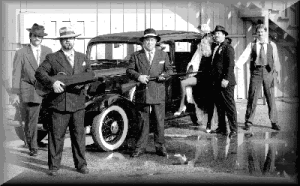On National Moonshine Day, We Bring You The True History Behind Moonshine
Moonshine is an originally a slang term for an illegally distilled spirit without government authorization. Today, moonshine has evolved into a more popular and legally purchased commercial product.
History of American Moonshine
The spirit has countless additional names otherwise known as white lightning, mountain dew, home-brew, hillbilly pop, and rotgut. Real moonshine is still illegal to produce, and when caught one can be jailed. Moonshine can be brewed numerous ways and is often produced in a forest or where one can hide their operation.
Distilling skills were passed down to America from the Scott-Irish settlers in Virginia. Prohibition was then passed in several states before the Civil War. When the 18th amendment was ratified in 1919, half of the country outlawed the consumption and purchase of alcohol (except for medicinal use.). Prohibition lasted for 13 years, creating a strong demand for spirits, resulting in the success of moonshine business.


>> This Louisville hotel celebrates the repeal of prohibition daily.
Moonshine distillation always happened at night to avoid getting caught. The production of the liquor was mainly in Appalachia due to the limited road network making it easy to dodge officers and it was also difficult and costly to transport corn crops, therefore first converting corn to whiskey increase the amount a horse could haul.
Once liquor was finished distilling, drivers known as bootleggers or runners smuggled the product across the US in cars that were specifically enhanced for speed and load capacities having extra room, good engines, and heavy duty absorbers to support the weight of alcohol. When prohibition ended, the drivers gained successful driving skills which later led to the formation of NASCAR.


Famous Moonshiners
Maggie Bailey the “Queen of Mountain Bootleggers” sold moonshine in Harlan Country to provide for her family. Additional moonshines such as Amos Owens and Marvin Popcorn Sutton also sold moonshine in nearby areas. Sutton’s life was turned into a realty TV show on the Discovery Channel named “Moonshiners.”



The Different Types of Stills
Plastic Still
A plastic still is used for distillation specially adapted for separating ethanol and water. Plastic stills can achieve a vapor alcohol content of 40%, They are most popular for home-brewing because they are cheap and easy to produce.
Column Still
A column still, or a continuous still consists of two columns. It can achieve a vapor alcohol of 96%.
Spiral Still
A spiral still is a type of column still with a slow air cooled distillation process, most commonly used for bootlegging. The heart source is typically a 300W dip heater. It is popular due to its simplicity and low production costs providing 95% alcohol.
Pot Still
A pot still is used to distill flavored liquors such as whisky but not rectified spirits. They operate on a batch distillation rather than on a continuous basis. They are traditionally made with copper and range in many sizes. Spirits that are distilled this way range from 60-80% ABV.
Moonshine Today
In modern usage, the term “moonshine” still implies the liquor is produced illegally, however it’s been marketed as a way to to provide a forbidden drinking experience. Distilleries throughout the US are producing legal moonshine and selling it in mason jars and jugs, embracing the history of the past.










